Published
- 12 min read
5 Ways AI in DevOps Enhances Application Deployment

Application deployment has come a long way with the rise of DevOps. It introduced automation, faster release cycles, and a culture of continuous delivery.
But even with these improvements, deployment is still weighed down by unnecessary complexity.
Before code goes live, teams often spend hours writing YAML files, configuring infrastructure, and maintaining CI/CD pipelines. Each new service adds more manual setup, making application deployment slower and riskier than it should be.
This is where AI in DevOps is changing the picture. By eliminating repetitive configurations, predicting risks, and optimizing pipelines, AI is transforming deployment into a smarter, self-learning process. Instead of managing complex setups, developers can now achieve one-click deployments powered by intelligent automation.
Here are the top use cases of AI in DevOps for application deployment.
1. Eliminating Manual YAML and Complex Setup
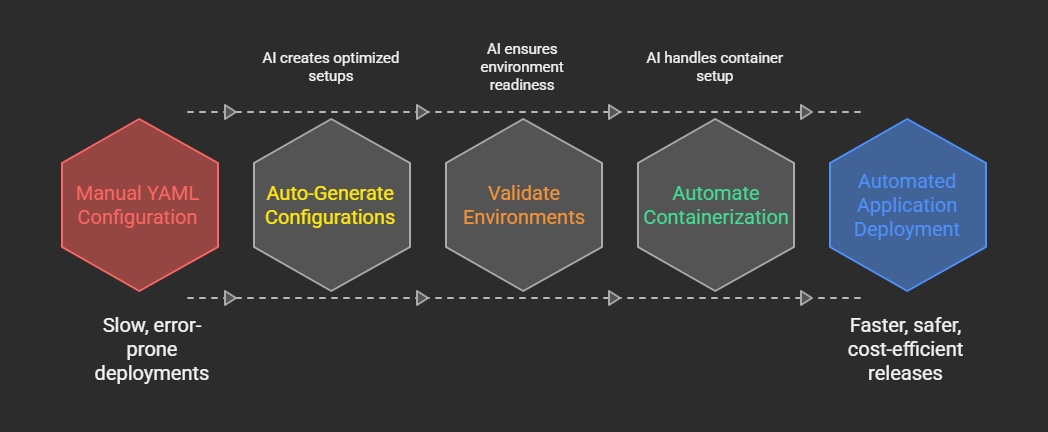 One of the biggest challenges in application deployment isn’t the code itself. It’s the setup that comes before deployment even begins. Developers spend countless hours writing YAML files, defining Helm charts, and stitching together configurations for containers, clusters, and CI/CD pipelines.
One of the biggest challenges in application deployment isn’t the code itself. It’s the setup that comes before deployment even begins. Developers spend countless hours writing YAML files, defining Helm charts, and stitching together configurations for containers, clusters, and CI/CD pipelines.
This manual setup not only slows down delivery but also increases the chances of errors. A single misconfigured YAML line can cause a failed build or even take down an entire environment. Teams end up spending more time debugging infrastructure than focusing on improving their applications.
This is where AI in DevOps brings a real advantage. Instead of requiring developers to define every detail in scripts, AI-driven application deployment tools can auto-generate configurations, validate environments, and create optimised setups on the fly.
For example, in a traditional deployment, a developer might:
- Write YAML files for deployments, services, and ingress rules
- Configure secrets, environment variables, and scaling rules manually
- Integrate monitoring and logging separately
With an AI-powered deployment tool, all of this can be eliminated. A developer can push code to GitHub, and the platform automatically handles containerization, environment setup, scaling rules, monitoring, and SSL, all without touching a single YAML file.
By removing YAML and complex setup from the equation, businesses not only accelerate releases but also reduce operational overhead, making deployments faster, safer, and more cost-efficient.
The result: faster launches, fewer headaches, and more time spent building features that matter.
Read this: How to Choose the Right Application Deployment Tool in 2025
2. Predictive Deployment Failures and Risk Management
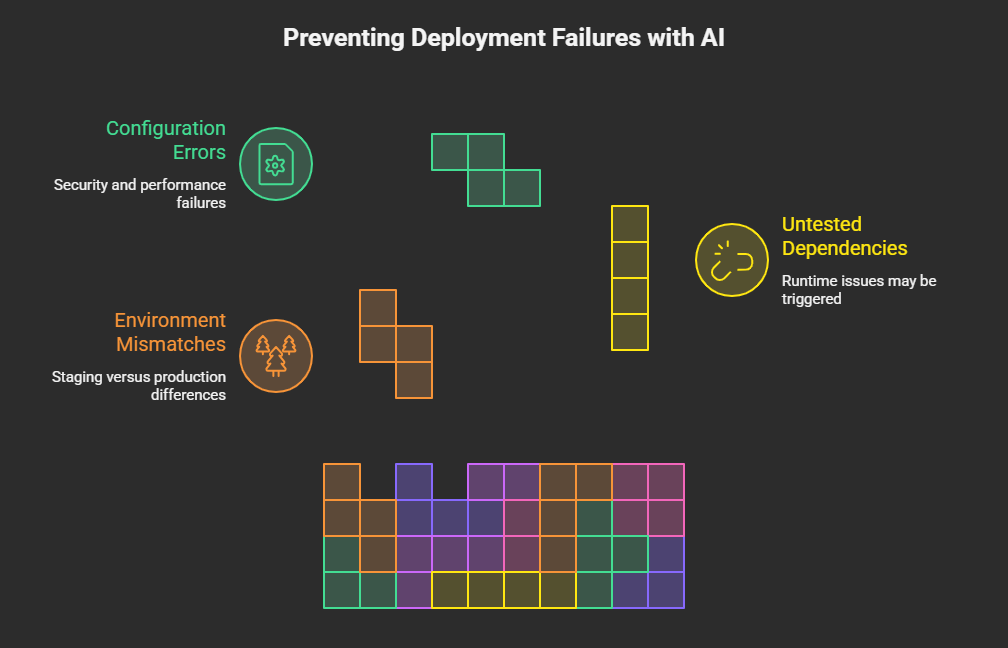 Even after the setup phase, deployments still carry risk. A small dependency mismatch, an environment variable error, or a misconfigured service can lead to downtime or failed releases. Traditional monitoring often reacts after something breaks, which means users are already impacted.
Even after the setup phase, deployments still carry risk. A small dependency mismatch, an environment variable error, or a misconfigured service can lead to downtime or failed releases. Traditional monitoring often reacts after something breaks, which means users are already impacted.
AI in DevOps brings a predictive layer to this problem. By analysing historical deployment data, logs, and error patterns, AI models can flag potential risks before the deployment even goes live. For example:
- Identifying environment mismatches between staging and production
- Detecting untested dependency updates that could cause runtime issues
- Highlighting configuration errors that might trigger security or performance failures
Take a realistic scenario:
Imagine a Node.js application that runs perfectly in staging with Node 18, but the production server is still configured with Node 16.
Normally, this mismatch wouldn’t be caught until the app crashes in production. With AI-based deployment insights, the system can automatically flag the version conflict and recommend the fix before release, saving hours of firefighting and preventing downtime for users.
Instead of waiting for something to break, AI-driven application deployment tools act as an early warning system, helping teams fix issues before users ever notice them. This dramatically increases deployment success rates and builds confidence in faster release cycles.
Instead of waiting for something to break, AI-driven application deployment tools act as an early warning system, helping teams fix issues before users ever notice them.
This dramatically increases deployment success rates and builds confidence in faster release cycles.
3. Intelligent Rollbacks and Auto-Healing
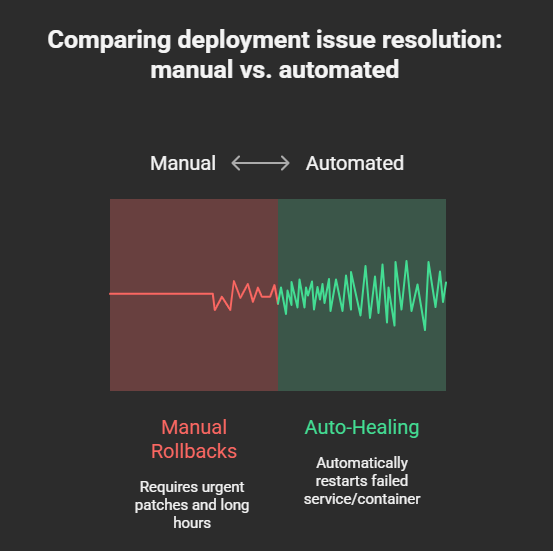 Even with the best preparation, not every deployment goes as planned. A new feature might introduce an unexpected bug, or a small config change could trigger performance issues under load.
Even with the best preparation, not every deployment goes as planned. A new feature might introduce an unexpected bug, or a small config change could trigger performance issues under load.
Traditionally, fixing these problems requires manual rollbacks, urgent patches, and long hours from the DevOps team.
With AI in DevOps, the response becomes automatic. AI-driven systems monitor applications in real time, detect anomalies immediately, and can roll back to the last stable state without human intervention. Auto-healing goes one step further. Instead of simply reverting, AI can identify the exact service or container that failed, restart it, and restore functionality.
Here’s a practical scenario: Imagine an e-commerce app rolling out a new checkout feature. Within minutes of deployment, the payment service starts showing elevated error rates.
In a traditional setup, engineers would scramble to analyse logs, identify the issue, and manually roll back.
With an AI-powered application deployment tool, the system detects the anomaly, rolls back the payment service to the last known good state, and restores checkout functionality automatically, often before customers even notice.
The result is higher availability, reduced Mean Time to Recovery (MTTR), and far less stress on development teams.
Related read: How Application Deployment Tools Work
4. Optimised CI/CD Pipelines with AI Insights
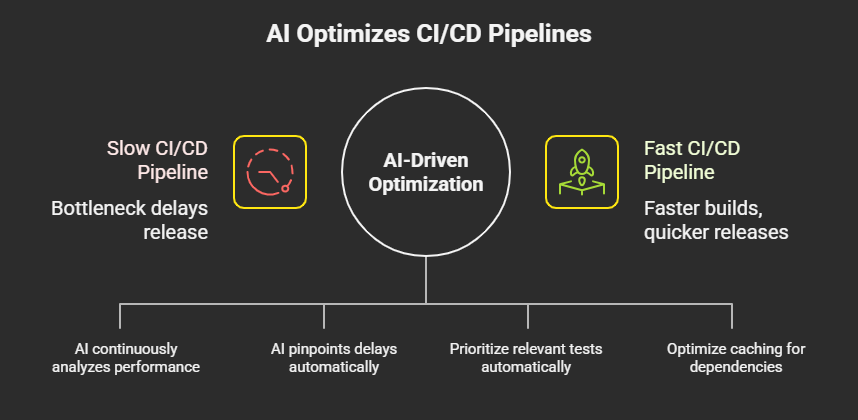 A major strength of DevOps is the CI/CD pipeline, which automates building, testing, and deploying applications. But in practice, pipelines often become bottlenecks.
A major strength of DevOps is the CI/CD pipeline, which automates building, testing, and deploying applications. But in practice, pipelines often become bottlenecks.
Slow builds, inefficient test execution, or misconfigured caching can delay release, which means lost revenue opportunities and higher operational costs.
This is where AI in DevOps adds real business value. AI-driven application deployment tools continuously analyse pipeline performance and suggest optimisations. Instead of engineers manually fine-tuning YAML scripts or guessing where delays come from, AI pinpoints bottlenecks and fixes them automatically.
Use case:
Imagine a SaaS company preparing for a major product update. Their CI/CD pipeline takes nearly 50 minutes for every build due to redundant integration tests and inefficient caching.
AI steps in, identifies that only 20% of the tests are relevant to the changed code, and automatically prioritises those. It also optimises caching for dependencies.
The result? Build times drop from 50 minutes to 12 minutes. That means the team can push new features faster, respond to customer feedback quicker, and reduce cloud compute costs tied to long build runs.
For the business, this translates into shorter release cycles, better agility, and a direct boost in ROI from DevOps investments.
5. Resource Forecasting and Deployment Scheduling
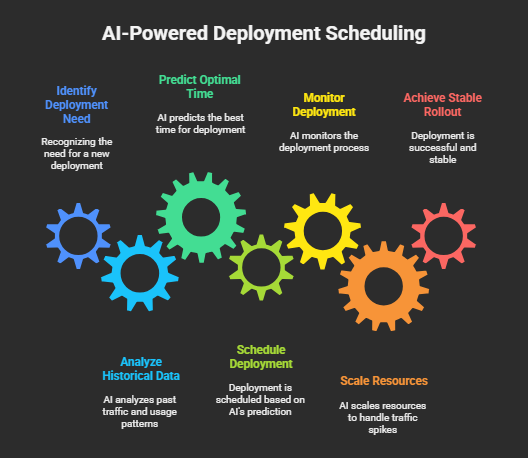 Even the smoothest deployments can fail if they’re released at the wrong time. High-traffic hours, peak workloads, or unoptimized resource allocation can make an otherwise successful rollout unstable. Teams often play it safe by deploying at midnight or on weekends, but that’s neither sustainable nor efficient.
Even the smoothest deployments can fail if they’re released at the wrong time. High-traffic hours, peak workloads, or unoptimized resource allocation can make an otherwise successful rollout unstable. Teams often play it safe by deploying at midnight or on weekends, but that’s neither sustainable nor efficient.
AI in DevOps changes this by bringing intelligence to scheduling and resource planning. By analysing historical traffic, user behaviour, and infrastructure usage, AI can recommend the most stable deployment windows. It can also predict when resources should be scaled up or down so applications remain steady during and after release.
Use case:
A fintech company plans to roll out a new payments API. Traditionally, the team would schedule it late at night to avoid traffic, requiring engineers to stay up for monitoring.
With an AI-powered application deployment tool, the system analyses traffic patterns and predicts a mid-morning slot where risk is lowest and resources are underutilised. During the release, AI automatically scales services to absorb any unexpected spikes.
The result: a stable rollout without manual guesswork, no downtime, and a well-rested engineering team.
By shifting from reactive firefighting to predictive scheduling, businesses can operate confidently during business hours, ensuring both stability and speed.
How Kuberns Solves This Problem?
 Every challenge we’ve discussed and the ones that follow are exactly what Kuberns was built to solve.
Every challenge we’ve discussed and the ones that follow are exactly what Kuberns was built to solve.
Instead of juggling multiple tools and writing scripts for every detail, Kuberns gives you a single platform where deployment becomes almost effortless.
Here’s what that looks like in practice:
- No more YAML or complex configs: Just connect your GitHub repo, and Kuberns handles the containerization, scaling, and environment setup for you.
- Built-in safety: With AI-powered checks, Kuberns spots risky deployments before they go live and rolls back automatically if something breaks.
- CI/CD without bottlenecks: Pipelines are optimised by AI, so builds run faster and tests don’t slow you down.
- Stable, stress-free releases: Kuberns predicts the best time to deploy and auto-adjusts resources, so you don’t have to wait for midnight rollouts.
- Everything in one place: Monitoring, logs, and alerts are included by default; no need to stitch together multiple dashboards.
- Lower costs on AWS: By optimising infrastructure in the background, Kuberns helps teams save up to 40% without lifting a finger.
| Feature | What It Means for You |
|---|---|
| No YAML, No Complexity | Connect your GitHub repo and deploy in one click. Kuberns handles containerization, scaling, and setup. |
| AI-Powered Safety | Built-in risk checks, auto rollbacks, and self-healing keep your apps stable without late-night firefighting. |
| Faster Pipelines | AI optimizes builds and tests, cutting bottlenecks so releases ship much faster. |
| Stress-Free Releases | Smart scheduling ensures stable rollouts and adjusts resources automatically. |
| Everything in One Place | Monitoring, logs, and alerts are included by default, no more juggling dashboards. |
| Lower AWS Costs | AI quietly optimizes infra usage, saving teams up to 40% on cloud bills. |
With Kuberns, deployment stops being a headache of YAML, configs, and late-night fixes.
It becomes what it should have always been: a one-click, AI-powered process that just works.
Ready to Leave YAML and Complexity Behind?
Deployments don’t need to be this hard.
Writing YAML files, managing configs, and stitching tools together only slows teams down. What we’ve seen is that AI in DevOps can take away a lot of that extra work, from spotting risks before release to handling rollbacks, speeding up pipelines, and keeping rollouts stable.
For most teams, the real win is simple: more time building features, less time fixing broken deployments.
That’s exactly what Kuberns was built for. Instead of managing five different tools, you connect your GitHub repo, hit deploy, and the platform takes care of everything, scaling, monitoring, rollbacks, and even saving on AWS costs.
👉 Start your next deployment the simple way, try Kuberns today.

Frequently Asked Questions
What is AI in DevOps?
AI in DevOps means using machine learning and automation to improve the software delivery pipeline. It helps with tasks like risk detection, auto-healing, pipeline optimisation, and resource management, so teams can deploy faster with fewer errors.
How does AI help in application deployment?
AI makes application deployment more reliable by eliminating manual configs, predicting failures before release, handling rollbacks, and keeping deployments stable with smart scheduling and monitoring.
Do I still need YAML files if I use AI-driven deployment tools?
Not always. Platforms like Kuberns remove the need for YAML and complex setup by automating containerization, scaling, and infra management, so you can deploy straight from GitHub with one click.
Can AI reduce deployment costs?
Yes. AI-driven deployment tools optimise resource usage, scale infrastructure automatically, and help teams avoid waste. For example, Kuberns can cut AWS costs by up to 40%.
Is AI in DevOps only for large enterprises?
No. AI-powered deployment tools are built for startups, agencies, and growing businesses as much as for enterprises. The goal is the same: faster releases, fewer failures, and lower costs.